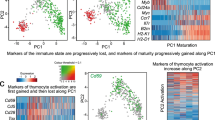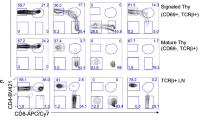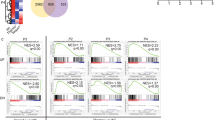Abstract
Major histocompatibility complex class I (MHC I) positive selection of CD8+ T cells in the thymus requires that T cell antigen receptor (TCR) signaling end in time for cytokines to induce Runx3d, the CD8-lineage transcription factor. We examined the time required for these events and found that the overall duration of positive selection was similar for all CD8+ thymocytes in mice, despite markedly different TCR signaling times. Notably, prolonged TCR signaling times were counter-balanced by accelerated Runx3d induction by cytokines and accelerated differentiation into CD8+ T cells. Consequently, lineage errors did not occur except when MHC I–TCR signaling was so prolonged that the CD4-lineage-specifying transcription factor ThPOK was expressed, preventing Runx3d induction. Thus, our results identify a compensatory signaling mechanism that prevents lineage-fate errors by dynamically modulating Runx3d induction rates during MHC I positive selection.
This is a preview of subscription content, access via your institution
Access options
Subscribe to this journal
Receive 12 print issues and online access
$209.00 per year
only $17.42 per issue
Buy this article
- Purchase on Springer Link
- Instant access to full article PDF
Prices may be subject to local taxes which are calculated during checkout







Similar content being viewed by others
References
Starr, T.K., Jameson, S.C. & Hogquist, K.A. Positive and negative selection of T cells. Annu. Rev. Immunol. 21, 139–176 (2003).
Singer, A., Adoro, S. & Park, J.H. Lineage fate and intense debate: myths, models and mechanisms of CD4- versus CD8-lineage choice. Nat. Rev. Immunol. 8, 788–801 (2008).
Palacios, E.H. & Weiss, A. Function of the Src-family kinases, Lck and Fyn, in T-cell development and activation. Oncogene 23, 7990–8000 (2004).
Veillette, A., Bookman, M.A., Horak, E.M. & Bolen, J.B. The CD4 and CD8 T cell surface antigens are associated with the internal membrane tyrosine-protein kinase p56lck. Cell 55, 301–308 (1988).
Barber, E.K., Dasgupta, J.D., Schlossman, S.F., Trevillyan, J.M. & Rudd, C.E. The CD4 and CD8 antigens are coupled to a protein-tyrosine kinase (p56lck) that phosphorylates the CD3 complex. Proc. Natl. Acad. Sci. USA 86, 3277–3281 (1989).
Shaw, A.S. et al. The lck tyrosine protein kinase interacts with the cytoplasmic tail of the CD4 glycoprotein through its unique amino-terminal domain. Cell 59, 627–636 (1989).
Norment, A.M., Salter, R.D., Parham, P., Engelhard, V.H. & Littman, D.R. Cell-cell adhesion mediated by CD8 and MHC class I molecules. Nature 336, 79–81 (1988).
Doyle, C. & Strominger, J.L. Interaction between CD4 and class II MHC molecules mediates cell adhesion. Nature 330, 256–259 (1987).
Haughn, L. et al. Association of tyrosine kinase p56lck with CD4 inhibits the induction of growth through the alpha beta T-cell receptor. Nature 358, 328–331 (1992).
Collins, E.J. & Riddle, D.S. TCR-MHC docking orientation: natural selection, or thymic selection? Immunol. Res. 41, 267–294 (2008).
Van Laethem, F. et al. Deletion of CD4 and CD8 coreceptors permits generation of alphabetaT cells that recognize antigens independently of the MHC. Immunity 27, 735–750 (2007).
Van Laethem, F., Tikhonova, A.N. & Singer, A. MHC restriction is imposed on a diverse T cell receptor repertoire by CD4 and CD8 co-receptors during thymic selection. Trends Immunol. 33, 437–441 (2012).
Van Laethem, F. et al. Lck availability during thymic selection determines the recognition specificity of the T cell repertoire. Cell 154, 1326–1341 (2013).
Taniuchi, I. & Ellmeier, W. Transcriptional and epigenetic regulation of CD4/CD8 lineage choice. Adv. Immunol. 110, 71–110 (2011).
He, X. et al. The zinc finger transcription factor Th-POK regulates CD4 versus CD8 T-cell lineage commitment. Nature 433, 826–833 (2005).
Sun, G. et al. The zinc finger protein cKrox directs CD4 lineage differentiation during intrathymic T cell positive selection. Nat. Immunol. 6, 373–381 (2005).
Taniuchi, I. et al. Differential requirements for Runx proteins in CD4 repression and epigenetic silencing during T lymphocyte development. Cell 111, 621–633 (2002).
Sato, T. et al. Dual functions of Runx proteins for reactivating CD8 and silencing CD4 at the commitment process into CD8 thymocytes. Immunity 22, 317–328 (2005).
Egawa, T., Tillman, R.E., Naoe, Y., Taniuchi, I. & Littman, D.R. The role of the Runx transcription factors in thymocyte differentiation and in homeostasis of naive T cells. J. Exp. Med. 204, 1945–1957 (2007).
Singer, A. New perspectives on a developmental dilemma: the kinetic signaling model and the importance of signal duration for the CD4/CD8 lineage decision. Curr. Opin. Immunol. 14, 207–215 (2002).
Littman, D.R. How Thymocytes Achieve Their Fate. J. Immunol. 196, 1983–1984 (2016).
Brugnera, E. et al. Coreceptor reversal in the thymus: signaled CD4+8+ thymocytes initially terminate CD8 transcription even when differentiating into CD8+ T cells. Immunity 13, 59–71 (2000).
Yu, Q., Erman, B., Bhandoola, A., Sharrow, S.O. & Singer, A. In vitro evidence that cytokine receptor signals are required for differentiation of double positive thymocytes into functionally mature CD8+ T cells. J. Exp. Med. 197, 475–487 (2003).
Park, J.H. et al. Signaling by intrathymic cytokines, not T cell antigen receptors, specifies CD8 lineage choice and promotes the differentiation of cytotoxic-lineage T cells. Nat. Immunol. 11, 257–264 (2010).
Katz, G. et al. T cell receptor stimulation impairs IL-7 receptor signaling by inducing expression of the microRNA miR-17 to target Janus kinase 1. Sci. Signal. 7, ra83 (2014).
Egawa, T. & Littman, D.R. ThPOK acts late in specification of the helper T cell lineage and suppresses Runx-mediated commitment to the cytotoxic T cell lineage. Nat. Immunol. 9, 1131–1139 (2008).
Luckey, M.A. et al. The transcription factor ThPOK suppresses Runx3 and imposes CD4(+) lineage fate by inducing the SOCS suppressors of cytokine signaling. Nat. Immunol. 15, 638–645 (2014).
McCaughtry, T.M., Wilken, M.S. & Hogquist, K.A. Thymic emigration revisited. J. Exp. Med. 204, 2513–2520 (2007).
Bosselut, R., Guinter, T.I., Sharrow, S.O. & Singer, A. Unraveling a revealing paradox: Why major histocompatibility complex I-signaled thymocytes “paradoxically” appear as CD4+8lo transitional cells during positive selection of CD8+ T cells. J. Exp. Med. 197, 1709–1719 (2003).
Yu, Q. et al. Cytokine signal transduction is suppressed in preselection double-positive thymocytes and restored by positive selection. J. Exp. Med. 203, 165–175 (2006).
Hanada, T. et al. A mutant form of JAB/SOCS1 augments the cytokine-induced JAK/STAT pathway by accelerating degradation of wild-type JAB/CIS family proteins through the SOCS-box. J. Biol. Chem. 276, 40746–40754 (2001).
Wiest, D.L. et al. Regulation of T cell receptor expression in immature CD4+CD8+ thymocytes by p56lck tyrosine kinase: basis for differential signaling by CD4 and CD8 in immature thymocytes expressing both coreceptor molecules. J. Exp. Med. 178, 1701–1712 (1993).
Stepanek, O. et al. Coreceptor scanning by the T cell receptor provides a mechanism for T cell tolerance. Cell 159, 333–345 (2014).
Erman, B. et al. Coreceptor signal strength regulates positive selection but does not determine CD4/CD8 lineage choice in a physiologic in vivo model. J. Immunol. 177, 6613–6625 (2006).
Chong, M.M. et al. Suppressor of cytokine signaling-1 is a critical regulator of interleukin-7-dependent CD8+ T cell differentiation. Immunity 18, 475–487 (2003).
Van De Wiele, C.J. et al. Thymocytes between the beta-selection and positive selection checkpoints are nonresponsive to IL-7 as assessed by STAT-5 phosphorylation. J. Immunol. 172, 4235–4244 (2004).
Wang, L. et al. Distinct functions for the transcription factors GATA-3 and ThPOK during intrathymic differentiation of CD4(+) T cells. Nat. Immunol. 9, 1122–1130 (2008).
Tarakhovsky, A. et al. A role for CD5 in TCR-mediated signal transduction and thymocyte selection. Science 269, 535–537 (1995).
Constantinides, M.G. & Bendelac, A. Transcriptional regulation of the NKT cell lineage. Curr. Opin. Immunol. 25, 161–167 (2013).
Itano, A. et al. The cytoplasmic domain of CD4 promotes the development of CD4 lineage T cells. J. Exp. Med. 183, 731–741 (1996).
Yin, X. et al. CCR7 expression in developing thymocytes is linked to the CD4 versus CD8 lineage decision. J. Immunol. 179, 7358–7364 (2007).
Saini, M. et al. Regulation of Zap70 expression during thymocyte development enables temporal separation of CD4 and CD8 repertoire selection at different signaling thresholds. Sci. Signal. 3, ra23 (2010).
Yu, W. et al. Continued RAG expression in late stages of B cell development and no apparent re-induction after immunization. Nature 400, 682–687 (1999).
Acknowledgements
We thank H. Park, D. Singer and N. Taylor for critical reading of the manuscript; M. Nussenzweig (Rockefeller University) for Rag2GFPTg mice; D. Littman (New York University) for Runx3dYFP knock-in reporter mice; R. Bosselut (National Cancer Institute) for ThpokGFP mice; M. Kubo (Tokyo University of Science, Japan) for SOCS1Tg mice; and S. Sharrow and L. Granger for flow cytometry. Supported by the Intramural Research Program of the US National Institutes of Health, National Cancer Institute, Center for Cancer Research, and the Ministry of Education, Culture, Science and Technology (Grant-in-Aid for Research Activity Start-up 26893033; and Scientific Research (C) 15K08524).
Author information
Authors and Affiliations
Contributions
M.Y.K. designed the study, performed experiments, analyzed data and contributed to the writing the manuscript. J.T., X.T., T.I.G., M.S., R.E., Z.L., P.L. and T.N. performed experiments, analyzed data and provided helpful discussions. A.S. designed the study, analyzed data and wrote the manuscript.
Corresponding authors
Ethics declarations
Competing interests
The authors declare no competing financial interests.
Integrated supplementary information
Supplementary Figure 1 Thymocyte differentiation defined by expression of CD69 and CCR7.
Frequency of MHCII−/−Rag2GFP thymocytes from Fig. 1a at stages 1-6 defined by CD69 and CCR7 expression (top left). TCRβ expression (top right) and CD4–CD8 expression (bottom) of the same cells are also shown. Numbers in two color contour plots depict the frequency of cells within each gate.
Supplementary Figure 2 Runx3d expression during MHC I positive selection.
Runx3d-YFP expression in CD69+DP, IM1, IM2, IM3, and SP8 thymocytes from OT-I Rag2−/− Runx3dYFP mice is displayed (left panels). CCR7 expression on gated Runx3d-YFP− and Runx3d-YFP+ cells is also displayed (right panels).
Supplementary Figure 3 TCR-ligand affinity affects phase 1 duration.
(a) Profiles of CD5 expression on just-signaled CD69+CCR7− DP thymocytes from monoclonal TCR transgenic mice (dark line) and polyclonal B6 mice (shaded curve). (b) Schematic models of MHC class I positive selection of thymocytes bearing relatively low (left) or high (right) affinity TCR to intra-thymic self-ligands.
Supplementary Figure 4 Effect of TCR signaling duration on cytokine-response potential.
Schematic model illustrating decreasing SOCS1 and increasing IL-7Rα expression with time of MHC class I TCR signaling. Thymocytes with greater cytokine response potential are more strongly signaled by cytokines which induce greater amounts of Runx3d.
Supplementary Figure 5 Lineage errors during MHC I positive selection.
(a) Stronger signaling CD8.4 coreceptors induce ThPOK expression during positive selection of OT-I thymocyes. Thpok-GFP expression was quantified in pre-selection DP and IM (CD4+CD8loCD69+) thymocytes (left), and in CD4 LNT cells (right). (b) Comparison of the number (top) and frequency (bottom) of CD4 LNT cells in OT-I mice expressing CD8wt or CD8.4 coreceptors. (c) CD69 expression on CD4 and CD8 LNT cells stimulated overnight with either medium or immobilized anti-TCR+anti-CD28 antibodies. (d) TCR-coreceptor mismatching decreases signaling and survival of peripheral OT-I CD4 T cells. CD5 expression on OT-I CD4 and CD8 LNT cells (left). Recent thymic emigrants (Rag2-GFP+ cells) are 4-times more frequent among OT-I CD4 mismatched LNT cells than OT-I CD8 matched LNT cells (right). (e) CD4 lineage errors upon CD5 deletion. Peripheral OT-I CD4 T cell frequencies in MHCII−/− chimeric host mice whose OTI T cells are CD5-sufficient or CD5-deficient. * P<0.05 and **P<0.001.
Supplementary information
Supplementary Text and Figures
Supplementary Figures 1–5 (PDF 646 kb)
Rights and permissions
About this article
Cite this article
Kimura, M., Thomas, J., Tai, X. et al. Timing and duration of MHC I positive selection signals are adjusted in the thymus to prevent lineage errors. Nat Immunol 17, 1415–1423 (2016). https://doi.org/10.1038/ni.3560
Received:
Accepted:
Published:
Issue Date:
DOI: https://doi.org/10.1038/ni.3560
This article is cited by
-
Mannosylated glycans impair normal T-cell development by reprogramming commitment and repertoire diversity
Cellular & Molecular Immunology (2023)
-
How autoreactive thymocytes differentiate into regulatory versus effector CD4+ T cells after avoiding clonal deletion
Nature Immunology (2023)
-
Reversal of the T cell immune system reveals the molecular basis for T cell lineage fate determination in the thymus
Nature Immunology (2022)
-
CD69 prevents PLZFhi innate precursors from prematurely exiting the thymus and aborting NKT2 cell differentiation
Nature Communications (2018)
-
Identification of lineage-specifying cytokines that signal all CD8+-cytotoxic-lineage-fate 'decisions' in the thymus
Nature Immunology (2017)



